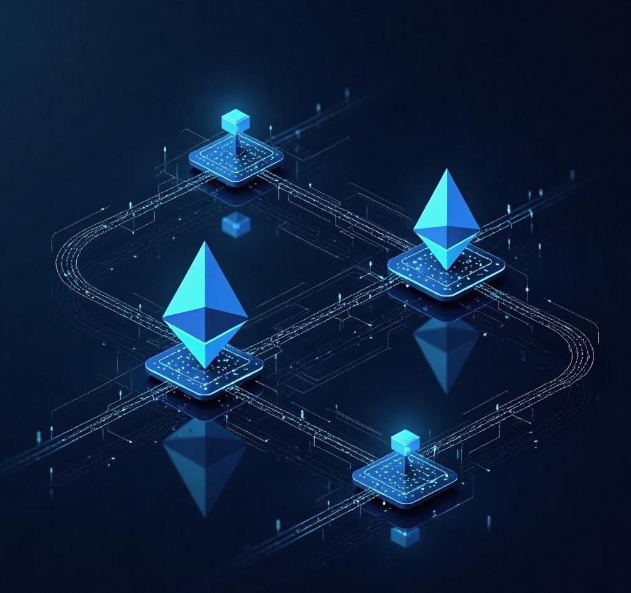How to Scale DApps with Polygon? Low-Cost and High-Performance Solutions
- latest articles
- 1.DApp Development & Customization: Merging Diverse Market Needs with User Experience 2.Analysis of the Core Technical System in DApp Project Development 3.How to achieve cross-chain interoperability in Web3 projects? 4.How does the tokenization of points reconstruct the e-commerce ecosystem? 5.How to Set and Track Data Metrics for a Points Mall? 6.What is DApp Development? Core Concepts and Technical Analysis 7.Inventory of commonly used Web3 development tools and usage tips 8.Development of a Distribution System Integrated with Social E-commerce 9.Six Key Steps for Businesses to Build a Points Mall System 10.What is DApp Development? A Comprehensive Guide from Concept to Implementation
- Popular Articles
- 1.Future Trends and Technology Predictions for APP Development in 2025 2.Analysis of the DeFi Ecosystem: How Developers Can Participate in Decentralized Finance Innovation 3.From Zero to One: How PI Mall Revolutionizes the Traditional E-commerce Model 4.DAPP Development | Best Practices for Professional Customization and Rapid Launch 5.Recommended by the Web3 developer community: the most noteworthy forums and resources 6.From Cloud Computing to Computing Power Leasing: Building a Flexible and Scalable Computing Resource Platform 7.How to Develop a Successful Douyin Mini Program: Technical Architecture and Best Practices 8.Shared Bike System APP: The Convenient Choice in the Era of Smart Travel 9.How to Create a Successful Dating App: From Needs Analysis to User Experience Design 10.From Design to Development: The Complete Process of Bringing an APP Idea to Life
In today's rapidly evolving blockchain technology landscape, decentralized applications (DApps) have become a crucial component across numerous industries. With the widespread adoption and development of the Ethereum blockchain, the demand for DApps is continuously increasing. However, despite Ethereum's robust support for DApps, high transaction fees and network scalability issues remain significant challenges. To address these problems, many developers are seeking more efficient and cost-effective blockchain solutions, with Polygon emerging as one of the most prominent among them.
Polygon (formerly Matic) is a multi-chain scaling solution designed to tackle Ethereum's bottlenecks by offering more efficient and lower-cost blockchain scaling services. Its emergence not only reduces development costs for developers but also enhances DApp performance, promoting the widespread adoption of decentralized applications. So, how can we leverage Polygon to scale DApps? This article will delve into how to use Polygon to achieve low-cost, high-performance DApp scaling.
1. What is Polygon?
Polygon is an Ethereum-based multi-chain scaling solution that helps developers address Ethereum's scalability and high-cost issues through sidechains and Layer 2 protocols. Its core objective is to enhance transaction throughput and reduce transaction costs, enabling Ethereum-based DApps to operate more efficiently.
Polygon not only provides low-cost, high-performance solutions but also supports an Ethereum-compatible development environment, allowing developers to utilize existing Ethereum tools and infrastructure (such as smart contracts, wallets, and development frameworks). Additionally, Polygon supports various scaling protocols like Plasma, Optimistic Rollups, and ZK-Rollups, offering flexible solutions for different application scenarios.
2. Why Choose Polygon to Scale DApps?
Low Transaction Costs
One of Polygon's greatest advantages is its low transaction fees. Compared to the Ethereum mainnet, Polygon's network fees are significantly lower, enabling developers to run DApps at a reduced cost, especially in scenarios with high user volumes and frequent transactions. Through Polygon, developers can effectively lower DApp operational costs and enhance user experience.High Throughput
Ethereum often faces bottlenecks when processing large volumes of transactions, leading to extended confirmation times and network congestion. In contrast, Polygon's multi-chain architecture enables high-throughput transaction processing, significantly boosting DApp performance. Polygon's inter-blockchain communication (IBC) mechanism also makes cross-chain operations more efficient, providing more options for DApp scaling.Ethereum Compatibility
Polygon is highly compatible with Ethereum, allowing developers to use existing Ethereum tools and frameworks (such as Solidity, Truffle, and Hardhat) without needing to learn new technology stacks. This enables Ethereum developers to seamlessly transition to Polygon and migrate their existing DApps to the Polygon network, benefiting from low fees and high throughput.Strong Ecosystem Support
Polygon boasts a robust developer community and ecosystem, with many renowned DeFi projects, NFT platforms, and gaming applications already deployed on it. Developers can leverage various tools, libraries, and resources within the Polygon ecosystem to accelerate the development and deployment of their DApps. Furthermore, Polygon supports interoperability with other blockchain networks, further expanding its application scenarios.
3. How to Use Polygon to Scale DApps?
To migrate or scale a DApp to Polygon, developers need to understand its basic working principles and operational steps. Below are the fundamental steps for scaling DApps using Polygon.
1. Set Up the Development Environment
First, developers need to set up a development environment suitable for Polygon. Fortunately, Polygon is compatible with Ethereum, allowing developers to use standard Ethereum development tools such as Solidity smart contract writing tools, the Truffle framework, and Hardhat.
In the development environment, developers need to complete the following steps:
Install Node.js: Ensure you have the latest version of Node.js to support the Polygon development environment.
Install Truffle or Hardhat: These tools help you develop, test, and deploy smart contracts.
Connect to the Polygon Network: Configure the Polygon network address in your development environment, which can be done by connecting to Polygon's testnet or mainnet via MetaMask or other wallets.
2. Deploy Smart Contracts to the Polygon Network
Similar to deploying smart contracts on Ethereum, deploying to Polygon is straightforward. Using Truffle or Hardhat, developers can directly deploy smart contracts to the Polygon network by changing the RPC address in the network configuration file to Polygon's network address. Polygon offers two common networks: Matic Mainnet and Matic Testnet.
Specific steps include:
Write Smart Contracts: Use Solidity to write smart contracts that meet the DApp's requirements.
Configure Truffle or Hardhat: Add Polygon's network configuration to the project's configuration file.
Deploy Contracts: Use Truffle's
migratecommand or Hardhat'sdeploycommand to deploy the smart contracts to the Polygon network.
3. Optimize DApp Frontend Interaction
Once smart contracts are successfully deployed on Polygon, the next step is to optimize the DApp's frontend interaction. Similar to Ethereum frontend interactions, Polygon's frontend interactions can be implemented using JavaScript libraries like Web3.js or Ethers.js.
Developers need to complete the following tasks:
Connect Polygon Wallet: Use MetaMask or other Polygon-supported wallets to connect to the DApp.
Call Polygon Contracts: Through Web3.js or Ethers.js, developers can call smart contracts deployed on the Polygon network.
Optimize User Experience: Due to Polygon's shorter transaction confirmation times, developers can optimize the DApp's user interface to make the transaction process smoother and faster.
4. Testing and Deployment
During development, developers can test on Polygon's testnet (such as Mumbai). The testnet provides free test tokens, allowing developers to verify DApp functionality and performance without spending real assets.
After testing, developers can deploy the DApp to Polygon's mainnet and interact with the smart contracts through the frontend interface.
4. Polygon's Optimization Strategies and Scaling Solutions
Polygon not only provides basic scaling functionality but also further optimizes DApp performance through a series of technical approaches. These optimization solutions primarily include:
Plasma Chains
Plasma is a Layer 2 scaling solution that reduces the main chain's burden by moving large volumes of transactions to child chains. Polygon supports the Plasma protocol, helping DApps increase transaction throughput while maintaining security.Optimistic Rollups
Optimistic Rollups is a scaling solution that batches transaction data and submits it to the main chain, only verifying when necessary. This approach effectively increases transaction speed and reduces costs.ZK-Rollups
ZK-Rollups utilize zero-knowledge proof technology to significantly enhance transaction throughput while ensuring security. Polygon also supports ZK-Rollups, enabling DApps to operate with lower costs and higher efficiency.
5. Conclusion
In the continuous development of blockchain applications, DApp scaling remains a critical challenge to address. With its low cost, high efficiency, and Ethereum compatibility, Polygon has become an ideal choice for developers scaling DApps. By effectively utilizing Polygon's scaling protocols and tools, developers can significantly reduce transaction costs and enhance DApp performance while maintaining decentralization advantages.
Whether building new decentralized applications or migrating existing Ethereum DApps, Polygon offers developers extensive support and solutions. As the Polygon ecosystem continues to develop and improve, decentralized applications will become more efficient and widespread, driving the broader adoption of blockchain technology.
-

DApp Development & Customization: Merging Diverse Market Needs with User Experience
As blockchain technology matures and becomes more widespread, decentralized appl···
-

Analysis of the Core Technical System in DApp Project Development
With the rapid development of blockchain technology, decentralized applications ···
-

What is DApp Development? Core Concepts and Technical Analysis
With the rapid development of blockchain technology, decentralized applications ···

 Blockchain
Blockchain












